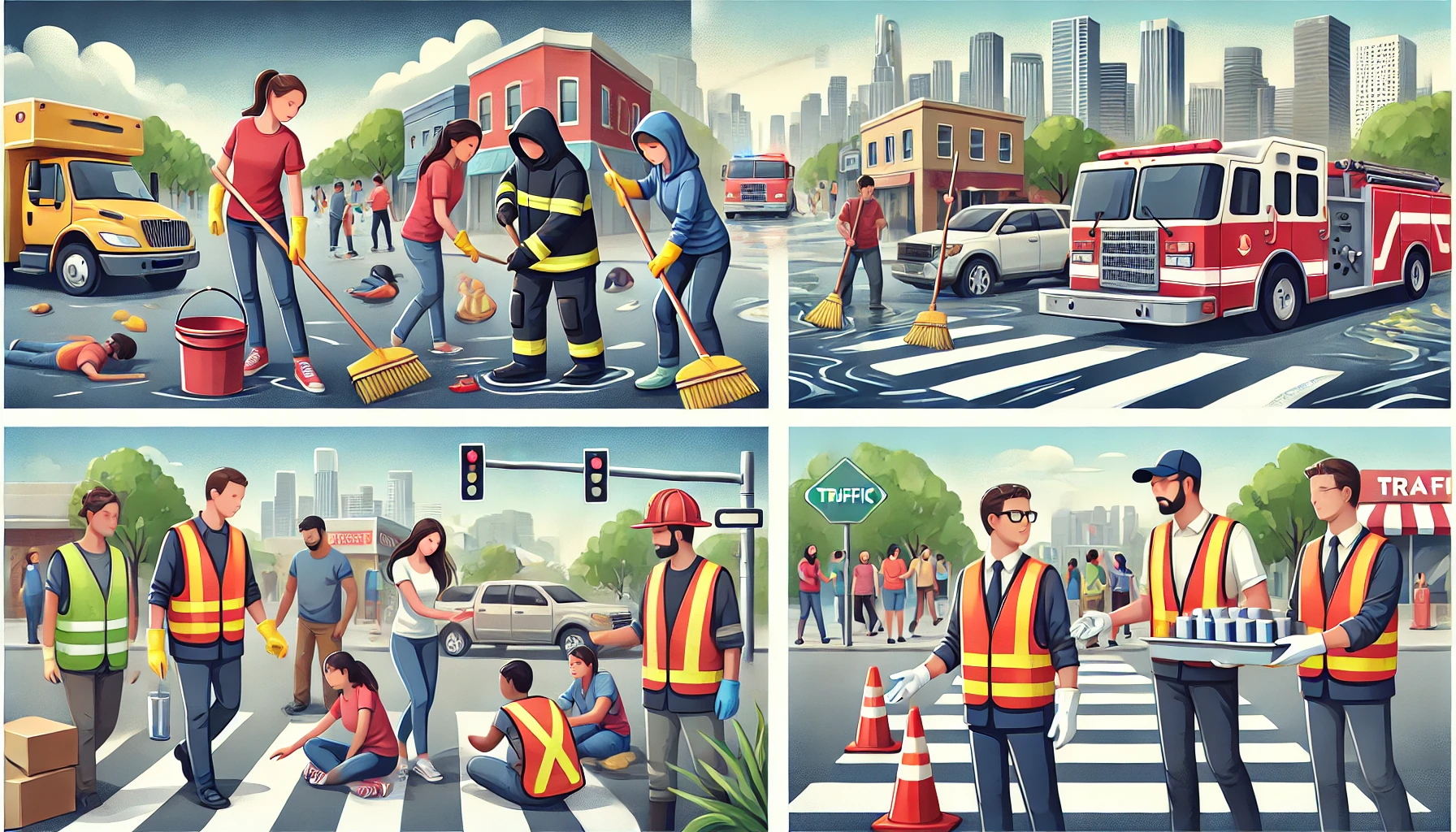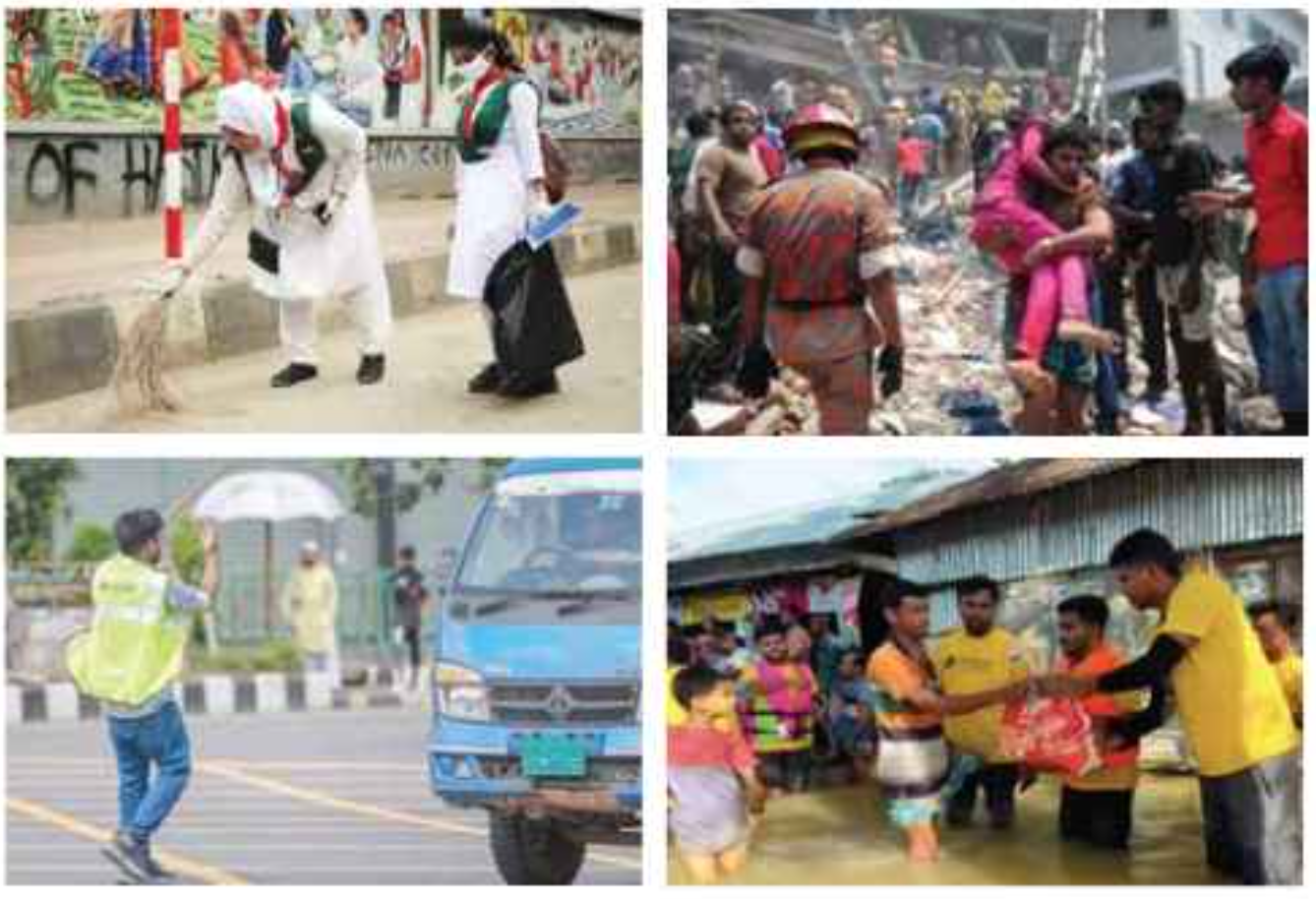HSC Unit 1; Lesson 4: Civic Engagement নাগরিক সম্পৃক্ততা

HSC Unit 1; Lesson 4: Civic Engagement
নাগরিক সম্পৃক্ততা
Question:
A. Look at the pictures. What are the people doing? Have you ever seen people doing similar kinds of activities in your locality?
✅ বাংলা:
ছবিগুলো দেখুন। মানুষ এখানে কী করছে? আপনি কি আপনার এলাকায় এ ধরনের কাজ করতে দেখেছেন?
Answer:
✅ English:
The pictures show different examples of civic engagement where people are actively participating in community service.
- The first image shows students cleaning the streets, which helps keep the environment clean and pollution-free.
- The second image depicts rescue workers saving people from a disaster, which highlights the importance of emergency response teams.
- The third image shows a volunteer managing traffic, ensuring road safety.
- The fourth image shows people distributing food and essential supplies to flood-affected victims.
Yes, I have seen people in my locality participating in similar activities. Volunteers from different organizations clean public places, provide disaster relief, and help maintain traffic discipline. These activities are essential for building a responsible and caring society.
✅ বাংলা:
ছবিগুলোতে নাগরিক সম্পৃক্ততার বিভিন্ন উদাহরণ দেখা যাচ্ছে, যেখানে মানুষ সক্রিয়ভাবে সমাজসেবামূলক কাজে অংশগ্রহণ করছে।
- প্রথম ছবিতে দেখা যাচ্ছে ছাত্র-ছাত্রীরা রাস্তা পরিষ্কার করছে, যা পরিবেশকে পরিষ্কার ও দূষণমুক্ত রাখতে সহায়তা করে।
- দ্বিতীয় ছবিতে উদ্ধারকর্মীরা দুর্যোগ থেকে মানুষকে উদ্ধার করছে, যা জরুরি উদ্ধার টিমের গুরুত্ব তুলে ধরে।
- তৃতীয় ছবিতে একজন স্বেচ্ছাসেবক ট্রাফিক নিয়ন্ত্রণ করছে, যা সড়কের নিরাপত্তা নিশ্চিত করছে।
- চতুর্থ ছবিতে দেখা যাচ্ছে যে কিছু মানুষ বন্যার্তদের মধ্যে খাবার ও প্রয়োজনীয় সামগ্রী বিতরণ করছে।
হ্যাঁ, আমি আমার এলাকায় একই ধরনের কাজ করতে মানুষকে দেখেছি। বিভিন্ন স্বেচ্ছাসেবী সংস্থা এবং ব্যক্তি রাস্তা পরিষ্কার করা, দুর্যোগ-সহায়তা প্রদান, এবং ট্রাফিক নিয়ন্ত্রণে সাহায্য করার মতো কাজ করে থাকে। এসব কার্যক্রম একটি দায়িত্বশীল ও সহানুভূতিশীল সমাজ গঠনে গুরুত্বপূর্ণ ভূমিকা রাখে।
B. Work in pairs. Discuss how the pictures are related to the lesson title – Civic Engagement.
✅ বাংলা:
বি. জোড়ায় কাজ করুন। আলোচনা করুন যে কীভাবে ছবিগুলো পাঠের শিরোনামের সাথে সম্পর্কিত – নাগরিক সম্পৃক্ততা।
Answer:
✅ English:
The pictures are directly related to the concept of Civic Engagement, as they depict people actively participating in community services.
- Cleaning Public Places: Some individuals, including students, are seen cleaning the streets, which promotes a clean and healthy environment.
- Rescue Operations: Firefighters and volunteers are rescuing people from a disaster, showing the importance of emergency response.
- Traffic Control: A volunteer is directing traffic, helping maintain road safety and discipline.
- Disaster Relief: Volunteers are distributing food and essential supplies to flood victims, showing humanitarian efforts.
These activities reflect responsible citizenship and community service, which are key aspects of Civic Engagement.
✅ বাংলা:
ছবিগুলো নাগরিক সম্পৃক্ততা (Civic Engagement) ধারণার সাথে সরাসরি সম্পর্কিত, কারণ এতে সমাজসেবামূলক কাজে মানুষের সক্রিয় অংশগ্রহণ দেখা যাচ্ছে।
- সড়ক পরিষ্কার: কিছু ব্যক্তি, বিশেষ করে শিক্ষার্থীরা, রাস্তা পরিষ্কার করছে, যা পরিচ্ছন্ন ও স্বাস্থ্যকর পরিবেশ নিশ্চিত করতে সহায়তা করে।
- উদ্ধার কার্যক্রম: দমকলকর্মী ও স্বেচ্ছাসেবকরা দুর্যোগ থেকে মানুষকে উদ্ধার করছে, যা জরুরি সেবার গুরুত্বকে বোঝায়।
- ট্রাফিক নিয়ন্ত্রণ: একজন স্বেচ্ছাসেবক ট্রাফিক পরিচালনা করছে, যা সড়কে শৃঙ্খলা ও নিরাপত্তা বজায় রাখতে সাহায্য করে।
- দুর্যোগ সহায়তা: স্বেচ্ছাসেবকরা বন্যার্তদের খাবার ও প্রয়োজনীয় সামগ্রী বিতরণ করছে, যা মানবিক সহায়তার উদাহরণ।
এই কার্যক্রমগুলো দায়িত্বশীল নাগরিকত্ব ও সমাজসেবা প্রতিফলিত করে, যা নাগরিক সম্পৃক্ততার (Civic Engagement) মূল উপাদান।
Instruction Part:
Read the texts below.
নিচের লেখাগুলি পড়ুন।
When you have finished reading,
আপনি যখন পড়া শেষ করবেন,
use the grid and write in your own words
তখন গ্রিড ব্যবহার করুন এবং আপনার নিজের ভাষায় লিখুন
how the three terms – civic engagement, volunteerism, and service learning – are similar and dissimilar.
এই তিনটি শব্দ—সিভিক এনগেজমেন্ট (সামাজিক সম্পৃক্ততা), ভলান্টিয়ারিজম (স্বেচ্ছাসেবকতা) এবং সার্ভিস লার্নিং (সেবামূলক শিক্ষা)—কীভাবে পরস্পরের সাথে মিল ও অমিল রয়েছে।
Main Passage:
Education aims to bring about positive changes in our behavior.
শিক্ষার লক্ষ্য হলো আমাদের আচরণে ইতিবাচক পরিবর্তন আনা।
It helps us try to change our lives as well as the society we live in.
এটি আমাদের জীবন পরিবর্তন করতে এবং সেইসাথে যে সমাজে আমরা বাস করি সেটিকে পরিবর্তন করতে সাহায্য করে।
Education that does not illuminate our minds
যে শিক্ষা আমাদের চিন্তাকে আলোকিত করে না
or does not inspire us to work for the community
অথবা আমাদের সমাজের জন্য কাজ করতে অনুপ্রাণিত করে না
is not complete at all.
তা মোটেও সম্পূর্ণ শিক্ষা নয়।
Education is not all about getting grades or receiving certificates
শিক্ষা শুধু ভালো নম্বর পাওয়া বা সার্টিফিকেট অর্জন করার জন্য নয়
– we use education to make life better.
– আমরা শিক্ষা ব্যবহার করি জীবনকে আরও ভালো করার জন্য।
We are expected to apply the knowledge, skills, and values that we learn in a classroom
আমরা যা শ্রেণিকক্ষে শিখি সেই জ্ঞান, দক্ষতা এবং মূল্যবোধ প্রয়োগ করার আশা করা হয়
in our engagement with the world that lies outside.
বাইরের বিশ্বে আমাদের সম্পৃক্ততার ক্ষেত্রে।
And we can do so in many different ways.
এবং আমরা এটি বিভিন্ন উপায়ে করতে পারি।
Let’s have a look at how education works.
আসুন দেখি, শিক্ষা কীভাবে কাজ করে।
Paragraph 1:
Learners’ civic engagement is highly appreciated all over the world.
শিক্ষার্থীদের নাগরিক সম্পৃক্ততা সারা বিশ্বে অত্যন্ত প্রশংসিত।
Civic engagement means working to make a difference in the civic life (the public life of the citizens as contrasted with private or personal life) of the community
নাগরিক সম্পৃক্ততা মানে হলো কমিউনিটির নাগরিক জীবনে (ব্যক্তিগত জীবনের বিপরীতে জনসাধারণের জীবন) পরিবর্তন আনার জন্য কাজ করা
using knowledge, skills, values, and motivation.
জ্ঞান, দক্ষতা, মূল্যবোধ এবং প্রেরণা ব্যবহার করে।
Civic engagement promotes the quality of life in a community
নাগরিক সম্পৃক্ততা একটি কমিউনিটিতে জীবনের মান উন্নত করে
by contributing to the improvement of health and well-being of the people.
লোকজনের স্বাস্থ্য ও কল্যাণ উন্নত করার মাধ্যমে।
Paragraph 2:
Civically engaged individuals recognize themselves as members of a larger social community
নাগরিকভাবে সম্পৃক্ত ব্যক্তিরা নিজেদের একটি বৃহত্তর সামাজিক সম্প্রদায়ের সদস্য হিসেবে স্বীকৃতি দেয়
and are concerned about civic issues.
এবং নাগরিক বিষয়গুলো নিয়ে চিন্তিত থাকে।
They consider themselves responsible citizens
তারা নিজেদের দায়িত্বশীল নাগরিক মনে করে
who take action or raise their voices against injustice, discrimination, and other forms of social ills.
যারা অন্যায়, বৈষম্য এবং অন্যান্য সামাজিক অসঙ্গতির বিরুদ্ধে পদক্ষেপ নেয় বা কণ্ঠ তোলে।
Paragraph 3:
In civic engagement, issues of public concern are crucial.
নাগরিক সম্পৃক্ততায়, জনস্বার্থ সংক্রান্ত বিষয়গুলো অত্যন্ত গুরুত্বপূর্ণ।
Civic engagement includes individual or group activities to protect public interests
নাগরিক সম্পৃক্ততার মধ্যে জনস্বার্থ রক্ষার জন্য ব্যক্তিগত বা দলগত কার্যক্রম অন্তর্ভুক্ত থাকে
and change the way the community values itself.
এবং কমিউনিটি নিজেদের মূল্যায়নের ধরন পরিবর্তন করতে সাহায্য করে।
For example, if you are protesting against any unjust decision of the local municipality
উদাহরণস্বরূপ, যদি আপনি স্থানীয় পৌরসভার কোনো অন্যায্য সিদ্ধান্তের বিরুদ্ধে প্রতিবাদ করেন
such as raising taxes or an act that might work against people’s interests,
যেমন কর বৃদ্ধি করা বা কোনো এমন পদক্ষেপ নেওয়া যা মানুষের স্বার্থের বিপক্ষে যায়,
you are civically engaged and your action is considered a civic engagement.
তাহলে আপনি নাগরিকভাবে সম্পৃক্ত হয়েছেন এবং আপনার এই পদক্ষেপ নাগরিক সম্পৃক্ততা হিসেবে বিবেচিত হবে।
This protest can be done in different ways such as organizing rallies, collecting signatures, making human chains, writing petitions, etc.
এই প্রতিবাদ বিভিন্ন উপায়ে করা যেতে পারে, যেমন: সমাবেশ আয়োজন করা, স্বাক্ষর সংগ্রহ করা, মানববন্ধন তৈরি করা, আবেদনপত্র লেখা ইত্যাদি।
You can also help control traffic in front of a school, help children to cross the roads,
আপনি স্কুলের সামনে যানবাহনের নিয়ন্ত্রণ করতে পারেন, শিশুদের রাস্তা পার হতে সাহায্য করতে পারেন,
work in a team to clean a park or a sea beach.
একটি দল হিসেবে পার্ক বা সমুদ্র সৈকত পরিষ্কার করতে পারেন।
You can also give some services to elderly people.
আপনি বয়স্ক ব্যক্তিদের কিছু সেবা প্রদান করতেও পারেন।
These are all examples of civic engagement as what you do directly affects the community.
এইসবই নাগরিক সম্পৃক্ততার উদাহরণ, কারণ আপনার এই কাজ সরাসরি কমিউনিটিকে প্রভাবিত করে।
When civic engagement is a part of an academic programme,
যখন নাগরিক সম্পৃক্ততা একটি শিক্ষাগত কর্মসূচির অংশ হয়,
and the learners’ engagement is assessed following a scale,
এবং শিক্ষার্থীদের সম্পৃক্ততা নির্দিষ্ট স্কেলের মাধ্যমে মূল্যায়ন করা হয়,
then it is called service learning.
তখন একে সেবামূলক শিক্ষা (service learning) বলা হয়।
It involves the application of knowledge and skills learned in the classroom
এটি শ্রেণিকক্ষে শেখা জ্ঞান ও দক্ষতার প্রয়োগের সাথে জড়িত,
and then making a complete plan of action i.e. preparing a budget,
এবং এরপর একটি সম্পূর্ণ কর্মপরিকল্পনা তৈরি করা হয়, যেমন: বাজেট প্রস্তুত করা,
starting the process of implementation,
বাস্তবায়নের প্রক্রিয়া শুরু করা,
involving people and activating operational strategies.
মানুষকে সম্পৃক্ত করা এবং কার্যকর কৌশল চালু করা।
When civic engagement is spontaneous but irregular
যখন নাগরিক সম্পৃক্ততা স্বতঃস্ফূর্ত কিন্তু অনিয়মিত,
and not a part of any academic programme,
এবং কোনো শিক্ষাগত কর্মসূচির অংশ নয়,
it is considered volunteerism.
তখন একে স্বেচ্ছাসেবকতা (volunteerism) বলা হয়।
C. Read the texts below. নিচের লেখাগুলি পড়ুন। When you have finished reading, আপনি যখন পড়া শেষ করবেন, use the grid and write in your own words তখন গ্রিড ব্যবহার করুন এবং আপনার নিজের ভাষায় লিখুন how the three terms – civic engagement, volunteerism, and service learning – are similar and dissimilar.
Here is how you can fill in the grid with the similarities and differences among Civic Engagement, Volunteerism, and Service Learning:
|
Civic Engagement |
Volunteerism |
Service Learning |
|
Definition: Active participation in community and public life to improve society. |
Definition: Offering time and effort freely to help others without expecting compensation. |
Definition: Combining community service with academic learning for practical application of knowledge. |
|
Key Focus: Social and community improvement through civic actions. |
Key Focus: Selfless service to help individuals or communities. |
Key Focus: Applying learned skills to real-world community issues while gaining academic credit. |
|
Example Activities: Protesting against injustice, signing petitions, advocating for policy changes. |
Example Activities: Helping in disaster relief, working in a food bank, cleaning parks. |
Example Activities: Organizing health camps as part of a medical course, conducting surveys for community development projects. |
|
Academic Connection: Not necessarily linked to education, but focuses on active citizenship. |
Academic Connection: No direct connection to academic courses. |
Academic Connection: Directly tied to an academic curriculum with learning objectives. |
|
Motivation: Driven by civic responsibility and long-term community welfare. |
Motivation: Driven by altruism and willingness to help others. |
Motivation: A mix of personal development, learning, and community service. |
Grid Explanation:
|
Civic Engagement (নাগরিক সম্পৃক্ততা) |
Volunteerism (স্বেচ্ছাসেবকতা) |
Service Learning (সেবামূলক শিক্ষা) |
|
Definition: Active participation in community and public life to improve society. |
Definition: Offering time and effort freely to help others without expecting compensation. |
Definition: Combining community service with academic learning for practical application of knowledge. |
|
সংজ্ঞা: সমাজ ও জনজীবনের উন্নতির জন্য সক্রিয় অংশগ্রহণ। |
সংজ্ঞা: অন্যদের সাহায্য করতে বিনামূল্যে সময় ও শ্রম দেওয়া, কোনো প্রতিদানের আশা ছাড়াই। |
সংজ্ঞা: একাডেমিক শিক্ষার সাথে কমিউনিটি সেবাকে সংযুক্ত করা, যাতে শেখার বাস্তব প্রয়োগ হয়। |
|
Key Focus: Social and community improvement through civic actions. |
Key Focus: Selfless service to help individuals or communities. |
Key Focus: Applying learned skills to real-world community issues while gaining academic credit. |
|
মূল লক্ষ্য: সামাজিক ও সম্প্রদায়ের উন্নয়ন নাগরিক কার্যক্রমের মাধ্যমে। |
মূল লক্ষ্য: নিঃস্বার্থভাবে ব্যক্তিগত বা সম্প্রদায়গত সাহায্য প্রদান। |
মূল লক্ষ্য: শেখা জ্ঞান বাস্তব জীবনের সমস্যার প্রয়োগ এবং শিক্ষাগত স্বীকৃতি পাওয়া। |
|
Example Activities: Protesting against injustice, signing petitions, advocating for policy changes. |
Example Activities: Helping in disaster relief, working in a food bank, cleaning parks. |
Example Activities: Organizing health camps as part of a medical course, conducting surveys for community development projects. |
|
উদাহরণ: অন্যায়ের বিরুদ্ধে প্রতিবাদ করা, স্বাক্ষর সংগ্রহ, নীতিগত পরিবর্তনের জন্য প্রচারণা। |
উদাহরণ: দুর্যোগ মোকাবেলা করা, ফুড ব্যাংকে সাহায্য করা, পার্ক পরিষ্কার করা। |
উদাহরণ: মেডিকেল কোর্সের অংশ হিসেবে স্বাস্থ্য শিবির পরিচালনা করা, সমাজ উন্নয়নের জন্য জরিপ করা। |
|
Academic Connection: Not necessarily linked to education, but focuses on active citizenship. |
Academic Connection: No direct connection to academic courses. |
Academic Connection: Directly tied to an academic curriculum with learning objectives. |
|
শিক্ষাগত সংযোগ: সরাসরি শিক্ষার সাথে সংযুক্ত নয়, তবে সক্রিয় নাগরিকত্বের উপর গুরুত্ব দেয়। |
শিক্ষাগত সংযোগ: শিক্ষাগত পাঠক্রমের সাথে সরাসরি সংযুক্ত নয়। |
শিক্ষাগত সংযোগ: নির্দিষ্ট একাডেমিক পাঠ্যক্রমের সাথে সরাসরি সম্পর্কিত। |
|
Motivation: Driven by civic responsibility and long-term community welfare. |
Motivation: Driven by altruism and willingness to help others. |
Motivation: A mix of personal development, learning, and community service. |
|
|



